|
The double handshake mechanism:
1st handshake: Requester -
Server
 The
requester submits his match request to the server, which returns a
list of possible matches, showing: (a) the degree of separation
between requester and recipient and (b) a short profile summary
describing the recipient. The
requester submits his match request to the server, which returns a
list of possible matches, showing: (a) the degree of separation
between requester and recipient and (b) a short profile summary
describing the recipient.
 It
is up to the requester to select the best profiles before the match
request is sent to the recipients. This allows for flexibility and
accuracy, since the Requester has full control over the distribution
of his request, and also handles the complex matching mechanism. It
is up to the requester to select the best profiles before the match
request is sent to the recipients. This allows for flexibility and
accuracy, since the Requester has full control over the distribution
of his request, and also handles the complex matching mechanism.
2nd handshake: Recipient -
Requester
 The
request is broadcast to matching Recipients. The request offers the recipient
both the content of the request and the degree of separation between him/her
and the Requester. Taking into account this information, the Recipients may
choose to answer the request (or not). Again, this allows for flexibility and
accuracy since recipients have the power to decide whether they know enough
about the content of the request as the well as the requestor to reply (or
not). The
request is broadcast to matching Recipients. The request offers the recipient
both the content of the request and the degree of separation between him/her
and the Requester. Taking into account this information, the Recipients may
choose to answer the request (or not). Again, this allows for flexibility and
accuracy since recipients have the power to decide whether they know enough
about the content of the request as the well as the requestor to reply (or
not).
 If
the Recipient accepts to answer the request, the second handshake is successful
and the match is complete. The Requester and Recipient can start exchanging
messages. If
the Recipient accepts to answer the request, the second handshake is successful
and the match is complete. The Requester and Recipient can start exchanging
messages.
F. SmallWorldz
Architecture
The system is built from/using six
distinct software components:
- The Jabber Server [13]: Handles instant messaging between users.
- The SmallWorldz Modules: Connect to the Jabber server to provide the SmallWorldz
service.
- The Database:
To store all user data.
- The Client:
The main user interface with SmallWorldz. It allows users to log in
and out of SmallWorldz, to send or receive requests and exchanges
messages with others.
- The Website
[14]: It allows the users to register, manage their account and
download the SmallWorldz client.
- The Installer
is user-friendly and fully automated software used to install the
client on a local computer. The installer, provided by ZeroG [15]
needs to be downloaded from the website.
4 Client
Software and Self-Assessment Capabilities
A. The SmallWorldz Client
Software
The SmallWorldz client
prototype is the interface between the user and the SmallWorldz
server. To provide you with a clear idea of the way the system works
we will describe, in a stepwise manner, the matching process. (Steps
that are an optional part of the matching procedure are not assigned
a number).
1.
The user starts the SmallWorldz client and inputs a unique
identifier, a personal password and the type (termed "topic") of
community of users he/she wishes to join. See Figure 6 (a).
2.
When a user logs on to the SmallWorldz server, all of the
sub-communities (termed "sub-topics") of the chosen community are
displayed in the SmallWorldz client. See Figure 6 (b).
- New users (as well as, on
occasion, existing users) are explicitly asked for their address
book. If the user agrees to provide some/all of his/her e-mail
addresses to the SmallWorlz server, then he/she is provided with a
tool to select those addresses that he/she wishes to release to the
server (only for SmallWorlz promotion). See Figure 6 (c).
- The "roster" window in Figure 6
(d) provides the user with a way of creating and editing a
personalized list - actually tree - of acquaintances that he/she has
made on SmallWorldz.
3. The user may also create or edit his/her own profile within
the SmallWorldz community. To do this, the user selects a number of
subtopics and chooses the criteria that best suit him. By doing so,
the user accepts to act as, at least an occasional, Recipient for
the requests of others in those subtopics of the greater community.
See Figure 7.
4.
This profile is public and is stored on the SmallWorldz server. Other users - referred to as Requesters may send their
match requests to the SmallWorldz server. See Figure 6 (b).
5. In reply to the Requester, the SmallWorldz server returns a
list of possible matches -seeFigure 8. The list
displays:
i. The current status of the Recipient (online or offline);
ii.The degree of separation between the Requester and the matched Recipients;
iii. A profile summary describing each of the Recipients.
6.
The SmallWorldz client displays the list of Recipients to let
the Requester scroll through it and select the type of people he/she
wishes to attempt to contact. The degree of separation gives the
requester a sense of proximity, which is hoped, will encourage the
exchange. See Figure 8.
7.
Once the Requester has chosen the Recipients, he/she sends
them his request directly. See Figure 8. The Recipients receive the
exchange request, which contains the degree of separation and a
natural language message from the Requester. It is up to the
Recipient to decide whether or not to accept the exchange, if he/she
does, the exchange can take place through instant messages (or
later, via other means, external to SmallWorldz, such as e-mail or
the public telephone network). See Figure 9.
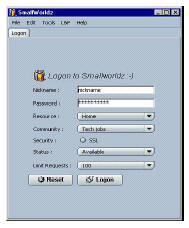
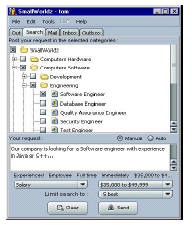
Figure 6 (a) Figure
6 (b)
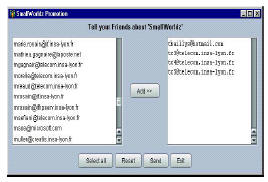
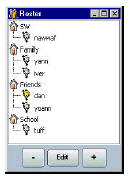
Figure 6
(c)
Figure 6 (d)
Figure 6 (a, b, c, d).
Views of the SmallWorldz client
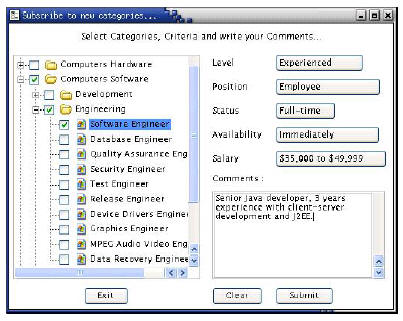
Figure7.
Subscribing to Categories within a Community
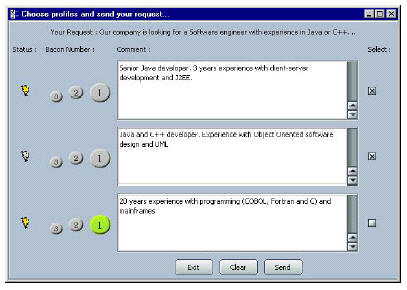
Figure 8.
List of Recipients
returned by the Server
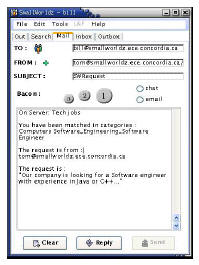
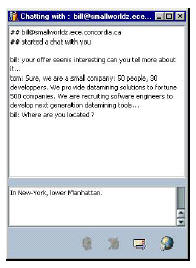
Figure 9.
Recipients Receive the Request and
Start Exchanging with the Requester
B. Automatic Self-evaluation of
System Usage
The next step is measuring system usage,
in terms of: basic demand for services; utility of social proximity;
mode of use; and effective promotion. In the sequel, we present a
sequence of important operational questions, followed by a number of
especially designed (and implemented) statistical metrics. These
statistics are useful in providing empirically based answers to the
questions.
The system does
all of the data collection, compilation and charting automatically.
·
Does the system attract demand, over time?
One statistic (figure 10) counts the number of connections. A
rising number of connections demonstrates the increasing popularity
of the system, whereas a decreasing number of connections indicates
diminishing user interest in the system. If the system helps people
get answers to their requests, connections should rise together
with the number of new subscribers.
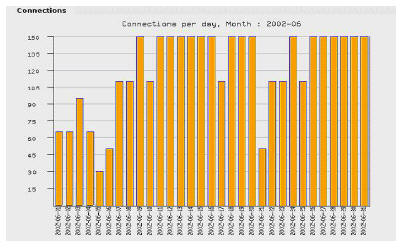
Figure 10.
Number of Connections per Month
·
Does human
proximity encourage online exchanges?
The use of a
matrix, as in figure 11, would show the correlation between the
number of exchanges between two users and their proximity. In other
words, does proximity encourage exchange? And does the average
number of exchanges between people go up as a function of proximity?
Figure 11.
Relationship between Proximity and
Exchanges
·
How do the users actually use the system?
A useful statistic (figure 12) would
show if the system is used mainly for matching people or just for
its instant messaging capabilities. In other words, are people
sending requests and trying to find people; or are they just
chatting with their friends?
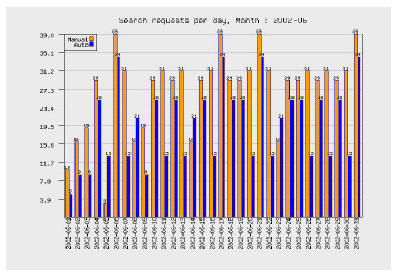
Figure 12.
Number of Search Requests per Month
·
Are people willing to promote the system by
releasing some of the addresses they have?
A useful statistic (figure 13) would
show the number of times the users submitted their address books to
the system. It would also show if the users are reluctant to
submitting their contact lists. SmallWorldz does not assume that a
great number of users will submit their address books to the server
since only a few will suffice to grow the system.
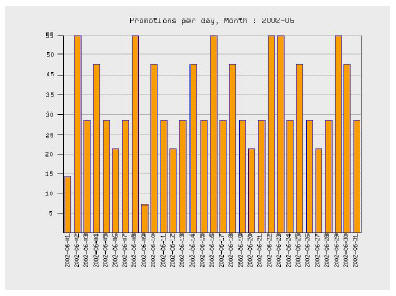
Figure 13.
New Address
Submissions
5 Summary and Future Work
Online exchanges between Internet users will definitely take on
a number of new dimensions in future years. Today, there is a lack
of tools that facilitate human networking over the Internet.
The system we propose is a step towards realizing such tools. Its
actual success depends on many pragmatic elements besides its
functional characteristics and technical robustness. However, we are
focused in this study
on explaining the conceptual
foundations of our system as well as its technical design and operation. Field
tests, already underway, in Montreal and Brussels, are using SmallWorldz
self-assessment capabilities to provide empirically-based answers to questions
about the system's feasibility as a real-world product (as opposed to a
research prototype).
SmallWorldz is
built on the basis of two fundamental principles: (a) people are a most invaluable
source of information, and other goods, potentially available via the
Internet. Hence, locating the right person(s) is usually a much more profitable
and efficient enterprise than searching for mute documents; (b) people need a trust-bridge,
of some form, which would encourage them to connect with each other. In
SmallWorldz, we use degree of separation, which is a simplistic, but reasonable
reflection of social proximity, as a means of encouraging communications and
hence exchange between apparently alien individuals.
It is our
belief that people are willing to seek other people; they just need a flexible,
effective, and non-intrusive method that would allow
them to engage in this endeavour. SmallWorldz attempts to realize this by: (a)
making sure that people have control over how they are contacted; (b)
ensuring that people provide profiles, which enhance the accuracy, and
hence efficiency, of the matching process; and (c) retaining all private
information, on users, on the central secure server.
If SmallWorldz
is to satisfy its mission of connecting people, many people, then it
must have a means of growth. SmallWorldz grows by explicitly asking for the
address books of SmallWorldz current users as well as new subscribers.
Thereafter, these addresses are used to invite new people to join the
community, and hence enrich it with their resources.
We envision
that the system can be used to create small communities in which users are
willing to meet others for online exchanges. Examples of such communities
include: (a) researchers looking for potential collaborators in a given field
of study; (b) university students looking for other students interested in
joining them in launching a new student society; and (c) single men and women
seeking partners for life or an adventure journey oversees!
REFERENCES
[1]
F. Hattori, T. Ohguro, M Yokoo, Matsubara, and S.
Yoshida. Socialware: Multiagent systems for supporting network
communities. In CACM, 42(3):55-61, March 1999.
[2]
Walter van de Velde. Co-Habited Mixed Realities. In
Proceedings of the IJCAI'97 Workshop on Social Interaction and Communityware,
Nagoya, Japan, August 1997.
[3] H.
Nakanishi, C. Yoshida, T. Nishimura, and T. Ishida.
FreeWalk: Supporting Casual Meetings in a Network. In Proceedings of the Conference on Computer Supported
Cooperative Work,
CSCW '96. ACM Press:
New York.
[4]
Bin Yu and Munindar P. Singh. A multi-agent referral
system for expertise location. In Working Notes of the AAAI Workshop on Intelligent Information Systems, pages 66-69, 1999.
[5] S. Milgram. The small world
problem. In Psychology Today 2, pp. 60-67, 1967.
[6] "The Small World
project": Department of sociology, Columbia
University, New York:
http://smallworld.columbia.edu
[7] Duncan J.
Watts. Six Degrees: The Science of a Connected Age. Norton,
2003.
[8]
J. Kleinfeld. Could
it be a big world after all? The six degrees of separation myth. Society, April 2002.
[9] J. Kleinfeld.
Six Degrees of Separation: An Urban Myth? Psychology Today,
April, 2001
[10] AskMeCorporation: Network your employees'
knowledge:
http://www.askme.com
[11]AllExperts: Free Online
Question and Answer service:
http://www.AllExperts.com
[12] Experts Exchange. IT solutions and experts:
http://www.experts-exchange.com
[13] Jabber Software foundation:
http://www.jabber.org
[14] SmallWorldz ©
website:
http://www.smallworldz.net
[15] ZeroG:
Multiplatform software installation and updating:
http://www.zerog.com
[16] T. Ishida.
Towards CommunityWare. In Proceedings of the second international conference and exhibition on the practical application of
intelligent agents and mutli-agent technology. Pp. 7-21. 1997.
[17] Yoshida,
S., Kamei, K., Yokoo, M., Ohguro, T., Funakoshi, K., Hattori, F.
Visualizing potential communities: a multiagent approach
1998. In Proceedings. International Conference on Multi Agent Systems, 3-7July1998. Page(s): 477 -478.
[18]
Fukuhara, T.,
Chikama, M., Nishida, T. Designing large-scale communityware: a case study in the Public Opinion
Channel. In Proceedings of the IEEE Workshop on
Knowledge Media Networking, 10-12 July 2002. Page(s): 120
-125.
Page 1, Page 2
| 
![]()
